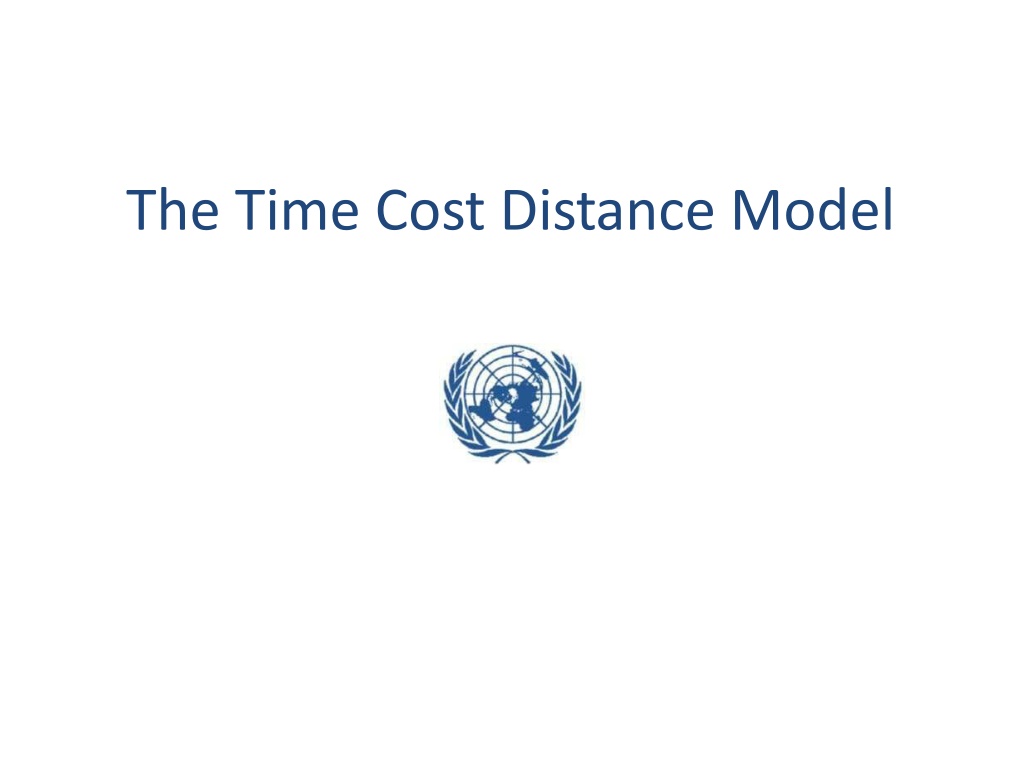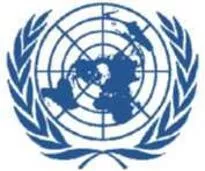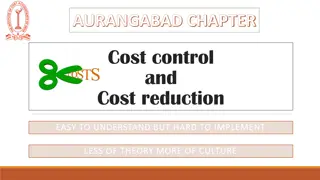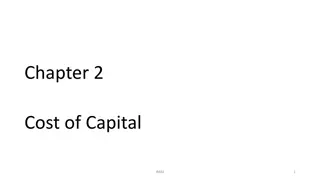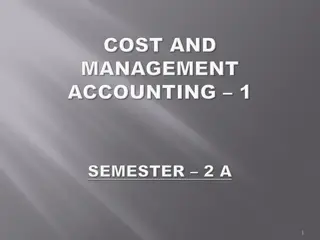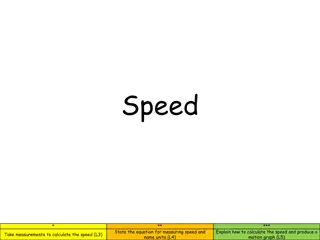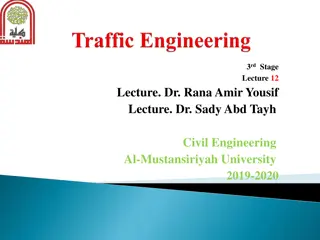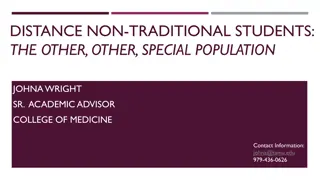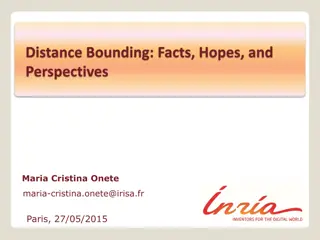The Time Cost Distance Model
The Time Cost Distance Model in Transit Corridors aims to illustrate the cost and time aspects of door-to-door movement along available routes and modes within a transit transport corridor while highlighting delays at borders or inspection points. The model proposes a methodology based on cost and time components, adapting from previous research and focusing on the variation in unit transport costs between different modes. It progresses through stages of competition between transport modes, combination of modes for cost-effectiveness, and ultimately, multimodal transport from origin to destination.
Uploaded on Oct 09, 2024 | 1 Views
Download Presentation

Please find below an Image/Link to download the presentation.
The content on the website is provided AS IS for your information and personal use only. It may not be sold, licensed, or shared on other websites without obtaining consent from the author.If you encounter any issues during the download, it is possible that the publisher has removed the file from their server.
You are allowed to download the files provided on this website for personal or commercial use, subject to the condition that they are used lawfully. All files are the property of their respective owners.
The content on the website is provided AS IS for your information and personal use only. It may not be sold, licensed, or shared on other websites without obtaining consent from the author.
E N D
Presentation Transcript
T Tr ransit ansitc corrid orrido or rper perf formance ormance Theobjectiveofthemodelistoproposeamethodologyto illustratethecostandtimecomponentsofdoor-to-door movementbyavailableroutesandmodesaswellasto illustratethedelaysatbordersorotherinspectionpoints uptothepointofdestinationwithinatransittransport corridor. Thecost/timemethodologyhasbeenadaptedfrom BeresfordandDubey(1990),asimprovedbyBanomyong (2000)andlaterdisseminatedbyUNESCAP. Themodelincludescostsandtimeassociatedwith transportbyanymodeandwithtransfersbetweenmodes. Themethodologyisbasedonthepremisethattheunit costoftransportvariesbetweenmodes
F Fo ou ur r d de ev vel elopm opme en nt tal alst sta ag ges, es, Stage1:Competitionbetweentwomodesof transport. Stage2:acombinationoftransportmodes,wherethecost oftransportbycombiningbothmodesislessexpensivethan justroadtransportandslightlymoreexpensivethanrail transport. Stage3:Combinedtransport,road-rail-sea. Stage4:Multimodaltransport,fromorigintodestination
S St tage age 1 1: : R Ro oa ad d vers versu us s ra rail il a al lt ter ern native ative Thedistanceandcost/timedataareplottedonthex-axisandy-axis,respectively. Initiallyroadtransportmaybecheaperthanrailtransportovershorterdistances, duetotheinitialcosts(ortime)requiredtotransportthegoodstotherailway station.However,asthedistanceincreases,thetwolinescrossandbeyondthis point,railtransporthasalowerperkilometrecostthanroadtransport,as indicatedbytheflatterslope.
S St tage age 2: 2: Combined Combined transpor rail rail transport t, , roa road d- - Inthefirstpartofthejourney,itischeapertotransportthegoodsbyroadratherthanbyrail. However,ifthedistancetobetravelledisfurtherthanthebreak-evendistance,transportby railbecomesmoreeconomical.Anintermodaltransfercanbearrangedattheclosestrail freightterminalorinlandclearancedepot(ICD).Theverticalstepinfigure3representsthe costs(ortime)involvedwhengoodsaretransshippedfromroadtorailattherailfreight terminalorICD.Thecostofrailtransport,inreality,hasnotincreasedbutthecostofthe intermodaltransferisreflectedinthecombinedtransportcostfromthatpointon.
S St tage age 3: 3: Combined Combined transpor rai rail l- -sea sea transport t, , roa road d- - Sincetheoverwhelmingmajorityoftradedgoodsaretransportedbysea,themostlikelydestinationforthefreight intransitwillbeaseaport,wherethegoodswillbetransferredontoseagoingvessels.Theadditionalcosts(or time)incurredattheportarerepresentedbythesecondverticalstep.Thus,cumulativecostsfromtheoriginto theportarethesumofthecostofrailtransporttotheICDplusthecostofintermodaltransferattheICDplusthe costofrailtransportfromtheICDtotheportplusthehandlingchargeattheport.
S St tage age 4: 4: Multimoda Multimodal l transpor origin origin t to o de des stination tination transport t, , from from Thefinalstageshowsthatnumerousmodesoftransportmaybeinvolvedforgoods tobemoveddoor-to-door.Ateachintermodaltransferpointtherewillbeacost (ortime)increaserepresentedbyaverticalstep.Shouldabordercrossingoccur alongtheroute,thebordercrossingcharges(andtimespent)canberepresented byanotherverticalshiftupwardsinthecostcurveatthatpoint,whichcanthenbe cumulatedwithothercosts.
S So ou ur rce ceand and Un Uni its tso of f I In nf form orma ati tion on Source:Thedatautilisedareobtainedduringinterviewswith transitandtransportserviceproviders,tradersand governmentalofficials. Units:Aunitofanalysismustbeagreedupon.Datasuchascost orquotesshouldconcerntheshipmentofoneTEUonafreight- all-kindbasisorforashipmentofaparticularproduct. Informationneeded: Originanddestinationofthecargo; Fullroutedetailsincludingbordercrossingsandmodaltransfers; Modeoftransportforeachleg; Distanceforeachleg; Transittimeforeachleg(inhoursordays);and Costorquotesforeachleg.
Sampl Sample e da dat ta at table able Leg Mode Distance Cost Cum. Cum. Transit Cum. (km) (US$) distance cost time Time (km) (US$) (hours) (hours) AtoB Road 100 100 50 50 4 4 - - 100 150 6 10 Border Crossing BtoC Road 70 170 30 180 3 13 - - 40 220 3 16 Intermodal transfer CtoD Rail 200 370 60 280 18 34 Port - - 20 300 6 40 DtoE Sea 800 1170 300 600 72 112 TOTAL 1170 600 112
Sampl Sample e graph graph Forcostsorquotes,thefigureshowstherelativecostofeachleg(ormode,whereapplicable),andtheapproximate proportionofnon-transportcostsinrelationtotransportcosts. Abreakdownofcostsatbordercrossingsorports,canhighlightareasforaction. Byplottingtimeagainstdistance,therelativespeedoftransittransportforeachleg(ormode)canbecompared,and bottlenecksattransshipmentpointscanbeidentified. Asaruleofthumb,thehighertheverticalstepthemorelikelythatthebordercrossingorthenodallinkisa bottleneck.
Results of Demo Run Tianjin - Ulaanbaatar Ulaanbaatar 1700km Day 4 04.18 a.m. 75 hrs 31 min. Day 3 Average speed 22.4 km/h Zamyn Uud 1000 km 02.30 a.m. Day 2 20 hrs 31 min. 05.59 a.m. 29 hrs 12 min. Day 1 Erenhot, 983 km Tianjin, 0 km 1,691 km 33.7 km/h 500 km 1000 km 1500 km 2000 km 3 hrs. 00 min. 4 hrs. 50 min. Transshipment: Customs: 3hrs.20min. (3.5min.perbox) 3hrs.35min. China, Mongolia, Shunting+train formation:
D Dimen imens si ion ons s no not t i inc ncl luded uded Inadditiontotransportationtimeandcosts, tradersandtransitserviceoperatorsmust alsotakeintoconsiderationthereliabilityof thetransitcorridor,intermsof: Allyearconsistencyoftransittimes; Frequencyandqualityofservices; Competitionbetweenserviceproviders Balanceoffreightvolumes;(emptyreturns) Predictabilityofcosts; Informalcontrolsandcheckpoints; Transportsafetyandsecurity,etc.
Thank you for your attention The Time Cost Distance Model
